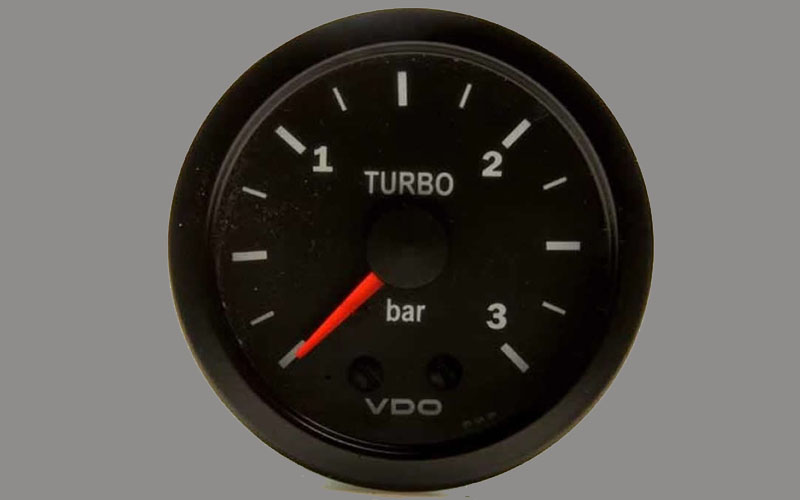3Bar Mechanical Turbo Boost Gauges
The VDO 3Bar Mechanical Turbo Boost Gauge is a reliable instrument designed to measure turbo boost pressure up to 3 bar. It features a clear, easy-to-read analog display, providing accurate readings of turbocharger performance. Ideal for automotive enthusiasts and performance vehicle owners, this mechanical gauge offers precise monitoring of boost levels, helping to optimize engine performance and prevent over-boost conditions. The VDO 3Bar Mechanical Turbo Boost Gauge combines durability with precise functionality, making it an essential tool for any turbocharged engine setup.
A 3Bar Mechanical Turbo Boost Gauge is a type of automotive instrument that measures and displays the boost pressure generated by a turbocharger in a vehicle's engine. It is designed to work in turbocharged or supercharged engines, where the forced induction system compresses air before it enters the engine to improve power output. The "3Bar" rating refers to the maximum pressure that the gauge can measure, which is 3 bar, or approximately 43.5 psi (pounds per square inch).
A 3Bar Mechanical Turbo Boost Gauge is a great option for high-performance cars or for those who want a durable, reliable method of monitoring turbo boost pressure. It's especially useful for drivers who want to ensure their turbo system is operating within safe limits, and for tuning purposes where precise monitoring is key.
3Bar Mechanical Turbo Boost Gauges Specification:
- Colour: Black
- Panel hole diameter: 52 mm - 2 1/16"
- Range: 0 tot 3 Bar Mechanical
- Connection: M12 x 1.5
- Retail package 1 Pressue gauge
Key Features of a 3Bar Mechanical Turbo Boost Gauge:
1. Measurement Range:
The "3Bar" rating typically indicates that the gauge can measure boost pressures from 0 to 3 bar (0 to 43.5 psi) of boost.
This is a relatively high measurement range, suitable for high-performance or heavily tuned turbo systems.
2. Mechanical Operation:
Mechanical boost gauges do not require electrical connections to function. Instead, they rely on a tube that is connected to the turbocharger's boost source (usually a vacuum/boost line that runs from the intake manifold).
As boost pressure builds in the system, it pushes a diaphragm or mechanical mechanism inside the gauge to indicate pressure.
3. Durability and Precision:
Mechanical gauges are often praised for their reliability and durability, as they lack the complexity of electrical components that could potentially fail.
They are generally less susceptible to electrical interference, making them a good choice for high-performance applications.
4. Scale and Display:
The gauge face usually displays pressure in both psi and bar, with the 3Bar scale indicating the maximum pressure.
Some gauges also use a color-coded scale to help easily identify different ranges of pressure, such as green for normal operating range, yellow or red for over-boost conditions.
5. Installation:
Installation of a mechanical boost gauge typically involves tapping into a vacuum line from the intake manifold or another boost pressure source. This line runs to the back of the gauge, where the pressure causes a needle to move across the scale.
Because it's mechanical, the installation tends to be straightforward, but care must be taken to ensure no leaks in the vacuum line, which could lead to inaccurate readings.
Common Uses of a 3Bar Turbo Boost Gauges:
Turbocharged or Supercharged Engines: If you have a turbo or supercharger on your engine, a boost gauge helps you monitor the pressure being produced by the turbocharger.
Performance Tuning: It allows drivers to monitor boost levels, which is essential for tuning the engine or ensuring that the system isn't producing more boost than the engine can handle.
Safety Monitoring: By keeping an eye on boost levels, drivers can avoid dangerous over-boost situations that could lead to engine damage.
Benefits:
Accurate Monitoring: Mechanical gauges are often considered more accurate in terms of reading boost pressure, especially when compared to electronic gauges, because there are fewer variables that could impact performance.
No Power Required: Since the mechanical gauge doesn't need electricity to operate, it can be more reliable in environments where electrical systems may fail or be affected by vibrations or interference.


